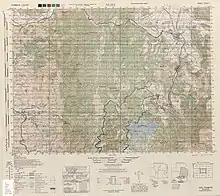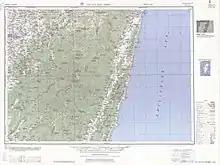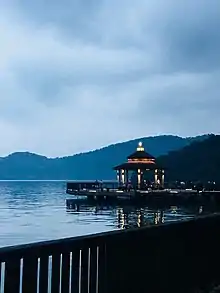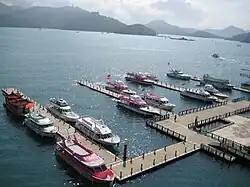| Sun Moon Lake | |
|---|---|
| Lake Candidius Zintun | |
| 日月潭 (Chinese) | |
 | |
_location_map.svg.png.webp) Sun Moon Lake | |
| Location | Yuchi, Nantou County, Taiwan |
| Coordinates | 23°52′N 120°55′E / 23.867°N 120.917°E |
| Type | Lake |
| Primary outflows | Shueili River |
| Surface area | 7.93 km2 (3.06 sq mi) |
| Max. depth | 27 m (89 ft) |
| Surface elevation | 748 m (2,454 ft) |
| Sun Moon Lake | |||||||||||||||||||||
|---|---|---|---|---|---|---|---|---|---|---|---|---|---|---|---|---|---|---|---|---|---|
"Sun Moon Lake" in Chinese characters | |||||||||||||||||||||
| Chinese | 日月潭 | ||||||||||||||||||||
| Literal meaning | "Sun Moon Pool" | ||||||||||||||||||||
| |||||||||||||||||||||
Sun Moon Lake (Chinese: 日月潭; pinyin: Rìyuè tán; Pe̍h-ōe-jī: Ji̍t-goa̍t-thâm; Thao: Zintun) is a lake in Yuchi Township, Nantou County, Taiwan. It is the largest body of water in Taiwan. The area around the lake is home to the Thao tribe, one of aboriginal tribes of Taiwan.[1] Sun Moon Lake surrounds a tiny island called Lalu.[2] The east side of the lake resembles a sun while the west side resembles a moon, hence the name.[3]
Sun Moon Lake is located 748 m (2,454 ft) above sea level. It is 27 m (89 ft) deep and has a surface area of approximately 7.93 km2 (3.06 sq mi). The area surrounding the lake has many trails for hiking.[1]
While swimming in Sun Moon Lake is usually not permitted, there is an annual 3-km race called the Swimming Carnival of Sun Moon Lake held around the Mid-Autumn Festival each year.[4][5] The Sun Moon Lake Swimming Carnival was launched in 1983[6] and is listed among the Top 50 Open Water Swims in Asia and the Top 100 Open Water Swims of the World.[7] Everyone over 10 years old and with the ability to swim long distances can join, regardless of nationality.[8] In recent years, the participants have numbered in the tens of thousands. Other festivities held at the same time include fireworks, laser shows, and concerts.
The lake and its surrounding countryside have been designated one of thirteen national scenic areas in Taiwan. Wen Wu Temple was built after rising water levels from building a dam forced several smaller temples to be removed.[9] Tzu-En Pagoda (慈恩塔; Cí'ēn Tǎ) was ordered constructed by late President Chiang Kai-shek in 1971 in memory of his mother.[10] Other temples of note include Jianjing Temple,[3] Syuentzang Temple[11] (玄奘寺; Xuánzàng Sì) and Syuanguang Temple[12] (玄光寺; Xuánguāng Sì).
History

In older English literature, it was commonly referred to as Lake Candidius after the 17th century Dutch missionary Georgius Candidius. In the middle of the lake is the Lalu Island, which is considered holy ground by the Thao tribe.[2] In legend, Thao hunters discovered Sun Moon Lake while chasing a white deer through the surrounding mountains. The deer eventually led them to the lake, which they found to be not only beautiful, but abundant with fish.[13] Today, the white deer of legends is immortalized as a marble statue on Lalu Island.


Under Japanese rule, the island was renamed "Jade Island" (Japanese: 玉島). After Chiang Kai-shek's Nationalist Government moved to Taiwan, the island was renamed Kwanghwa Island (Chinese: 光華島; lit. 'glorious China island') and in 1978 the local government built a pavilion where annual weddings took place. In 1999, the 921 earthquake destroyed the pavilion and sank most of the island. In recent years, due to increasing social and political awareness, more deference and recognition are being given to Taiwanese aborigines. As a result, after the 921 earthquake, the island was renamed in the Thao language as "Lalu".[14]
Several hydroelectric power plants have been built in the Sun Moon Lake since 1919, including Mingtan Pumped Storage Hydro Power Plant and Minhu Pumped Storage Hydro Power Station. When the first hydroelectric plant was finished in 1934, it was considered to be one of the most important infrastructure constructions of the time. Wujie Dam, also completed in 1934, diverts water from the Zhuoshui River to increase hydroelectric generation at the lake. The Jiji Line railroad was built to facilitate the construction.
Transportation
There are three ferry piers on the lake to serve ferries on the lake; they are Shuishe Pier, Xuanguang Pier and Ita Thao Pier. There is also a local bus service that goes around the lake with stops at major points along the perimeter of the lake.
The lake is accessible by bus from Taichung HSR station or Taichung TRA station.[15] It is also accessible by bus from near Checheng railway station on the Jiji branch line.

The Sun Moon Lake Ropeway, located at the edge of the lake, connects it with the Formosan Aboriginal Culture Village.[16]
Wildlife
The lake is a productive aquatic ecosystem. Introduced giant snakehead pose a challenge to the ecological balance of the lake and are a threat to native fish and shrimp species. The Nantou County Bureau of Agricultural Affairs has in place an eradication program for the species which attempts to electrofish schools of juvenile fish.[17]
PRC passport
The depiction of Sun Moon Lake is featured in the newly-issued People's Republic of China passport in 2012, a move that has triggered protest from Taipei to Beijing.[18]
Climate
| Climate data for Sun Moon Lake (1991–2020 normals, extremes 1941–present) | |||||||||||||
|---|---|---|---|---|---|---|---|---|---|---|---|---|---|
| Month | Jan | Feb | Mar | Apr | May | Jun | Jul | Aug | Sep | Oct | Nov | Dec | Year |
| Record high °C (°F) | 29.2 (84.6) |
30.0 (86.0) |
31.2 (88.2) |
32.8 (91.0) |
32.8 (91.0) |
33.3 (91.9) |
34.0 (93.2) |
33.5 (92.3) |
33.3 (91.9) |
32.5 (90.5) |
30.7 (87.3) |
29.4 (84.9) |
34.0 (93.2) |
| Mean daily maximum °C (°F) | 19.4 (66.9) |
20.3 (68.5) |
22.1 (71.8) |
24.2 (75.6) |
26.0 (78.8) |
27.2 (81.0) |
28.3 (82.9) |
27.8 (82.0) |
27.2 (81.0) |
25.6 (78.1) |
23.6 (74.5) |
20.5 (68.9) |
24.3 (75.8) |
| Daily mean °C (°F) | 14.4 (57.9) |
15.2 (59.4) |
16.9 (62.4) |
19.2 (66.6) |
21.1 (70.0) |
22.3 (72.1) |
22.9 (73.2) |
22.7 (72.9) |
22.2 (72.0) |
20.6 (69.1) |
18.6 (65.5) |
15.6 (60.1) |
19.3 (66.8) |
| Mean daily minimum °C (°F) | 11.3 (52.3) |
12.1 (53.8) |
13.9 (57.0) |
16.3 (61.3) |
18.5 (65.3) |
19.7 (67.5) |
20.1 (68.2) |
20.0 (68.0) |
19.5 (67.1) |
17.9 (64.2) |
15.7 (60.3) |
12.7 (54.9) |
16.5 (61.7) |
| Record low °C (°F) | −0.3 (31.5) |
−0.1 (31.8) |
1.0 (33.8) |
6.3 (43.3) |
12.4 (54.3) |
13.9 (57.0) |
16.2 (61.2) |
15.8 (60.4) |
12.9 (55.2) |
11.2 (52.2) |
5.9 (42.6) |
1.5 (34.7) |
−0.3 (31.5) |
| Average precipitation mm (inches) | 56.7 (2.23) |
72.0 (2.83) |
103.1 (4.06) |
174.6 (6.87) |
354.6 (13.96) |
441.6 (17.39) |
394.5 (15.53) |
422.9 (16.65) |
192.1 (7.56) |
50.3 (1.98) |
38.4 (1.51) |
42.2 (1.66) |
2,343 (92.23) |
| Average precipitation days (≥ 0.1 mm) | 7.9 | 8.2 | 10.6 | 13.4 | 18.3 | 20.0 | 18.3 | 19.0 | 12.0 | 5.9 | 5.3 | 6.4 | 145.3 |
| Average relative humidity (%) | 76.9 | 78.4 | 80.4 | 82.3 | 84.4 | 85.1 | 84.5 | 85.5 | 84.1 | 81.9 | 79.2 | 77.3 | 81.7 |
| Mean monthly sunshine hours | 159.4 | 136.9 | 128.5 | 109.5 | 109.2 | 111.3 | 140.6 | 125.2 | 123.6 | 147.6 | 160.2 | 157.0 | 1,609 |
| Source: Central Weather Bureau[19][20][21][22][23] | |||||||||||||
See also
References
- 1 2 "Sun Moon Lake has it all for tourists". The China Post. 2007-12-27. Archived from the original on 2021-01-22. Retrieved 2010-07-27.
- 1 2 "Lalu Island". Sun Moon Lake National Scenic Area Administration. Archived from the original on 2012-07-28. Retrieved 2010-07-27.
- 1 2 "Jioulongkou". Sun Moon Lake National Scenic Area Administration. Archived from the original on 21 November 2015. Retrieved 9 September 2015.
- ↑ "Cross-Sun Moon Lake swim draws record number of participants". Central News Agency. 2009-09-20. Archived from the original on 2016-08-10. Retrieved 2010-07-27.
- ↑ "Race at Sun Moon Lake attracts 20,000 applicants". Taipei Times. 2007-09-12. Archived from the original on 2009-05-31. Retrieved 2010-07-27.
- ↑ "Sun Moon Lake Swimming Carnival". Sun Moon Lake National Scenic Area Administration. Archived from the original on 2019-01-23. Retrieved 2018-08-01.
- ↑ "Sun Moon Lake International Swimming Carnival". Open Water Swimming Race Calendar. Archived from the original on 2018-08-01. Retrieved 2018-08-01.
- ↑ "Sun Moon Lake Swimming Carnival". rove.me. Archived from the original on 2018-08-01. Retrieved 2018-08-01.
- ↑ "Wenwu Temple". Sun Moon Lake National Scenic Area Administration. Archived from the original on 2014-08-03. Retrieved 2010-07-27.
- ↑ "Ci En Pagoda". Sun Moon Lake National Scenic Area Administration. Archived from the original on 18 April 2016. Retrieved 9 September 2015.
- ↑ "Syuentzang Temple". Sun Moon Lake National Scenic Area Administration. Archived from the original on 17 April 2015. Retrieved 9 September 2015.
- ↑ "Syuanguang Temple". Sun Moon Lake National Scenic Area Administration. Archived from the original on 9 August 2016. Retrieved 9 September 2015.
- ↑ "Oops!! 您輸入的網址不存在喔!!". Archived from the original on 2010-11-08. Retrieved 2010-11-05.
- ↑ "Sun Moon Lake - la Lu Isle". Archived from the original on 2007-11-22. Retrieved 2007-11-22.
- ↑ "Timetable-Sun Moon Lake Route Taiwan Tourist Shuttle Bus Info". Archived from the original on 22 June 2018. Retrieved 23 January 2018.
- ↑ "Sun Moon Lake Ropeway - Nantou County List of Attractions - Taiwan Travel - Tourguide | TravelKing". Archived from the original on 2022-01-31. Retrieved 2022-01-31.
- ↑ Chieh-yu, Hsieh; Madjar, Kayleigh. "Nantou urges action on giant snakeheads". www.taipeitimes.com. Taipei Times. Archived from the original on 18 July 2021. Retrieved 18 July 2021.
- ↑ "Taipei protests China's new passports". Taipei Times. 2012-11-24. Archived from the original on 2012-11-28. Retrieved 2012-11-24.
- ↑ "Monthly Mean". Central Weather Bureau. Archived from the original on 9 December 2022. Retrieved 29 November 2022.
- ↑ "氣象站各月份最高氣溫統計" (PDF) (in Chinese). Central Weather Bureau. Archived (PDF) from the original on 17 October 2022. Retrieved 29 November 2022.
- ↑ "氣象站各月份最高氣溫統計(續)" (PDF) (in Chinese). Central Weather Bureau. Archived (PDF) from the original on 17 October 2022. Retrieved 29 November 2022.
- ↑ "氣象站各月份最低氣溫統計" (PDF) (in Chinese). Central Weather Bureau. Archived (PDF) from the original on 19 February 2022. Retrieved 29 November 2022.
- ↑ "氣象站各月份最低氣溫統計(續)" (PDF) (in Chinese). Central Weather Bureau. Archived (PDF) from the original on 19 December 2022. Retrieved 29 November 2022.
External links
- Sun Moon Lake website Archived 2010-07-22 at the Wayback Machine
 Geographic data related to Sun Moon Lake at OpenStreetMap
Geographic data related to Sun Moon Lake at OpenStreetMap
